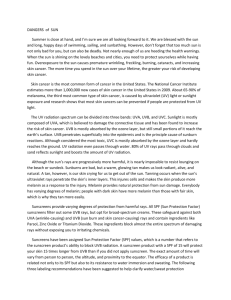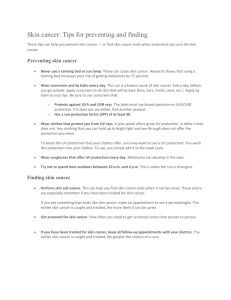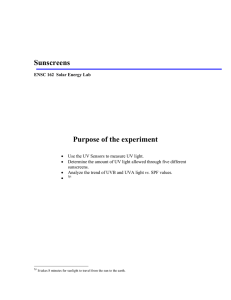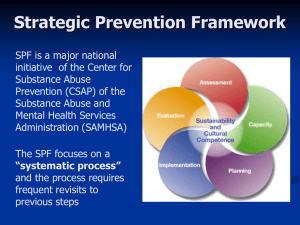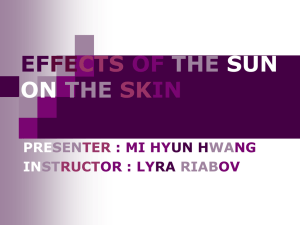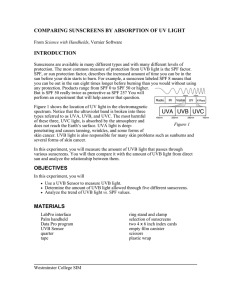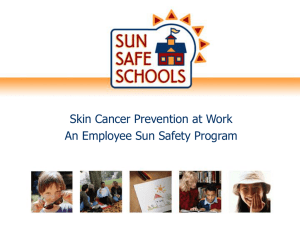Vernier LabQuest Comparing Sunscreens
advertisement
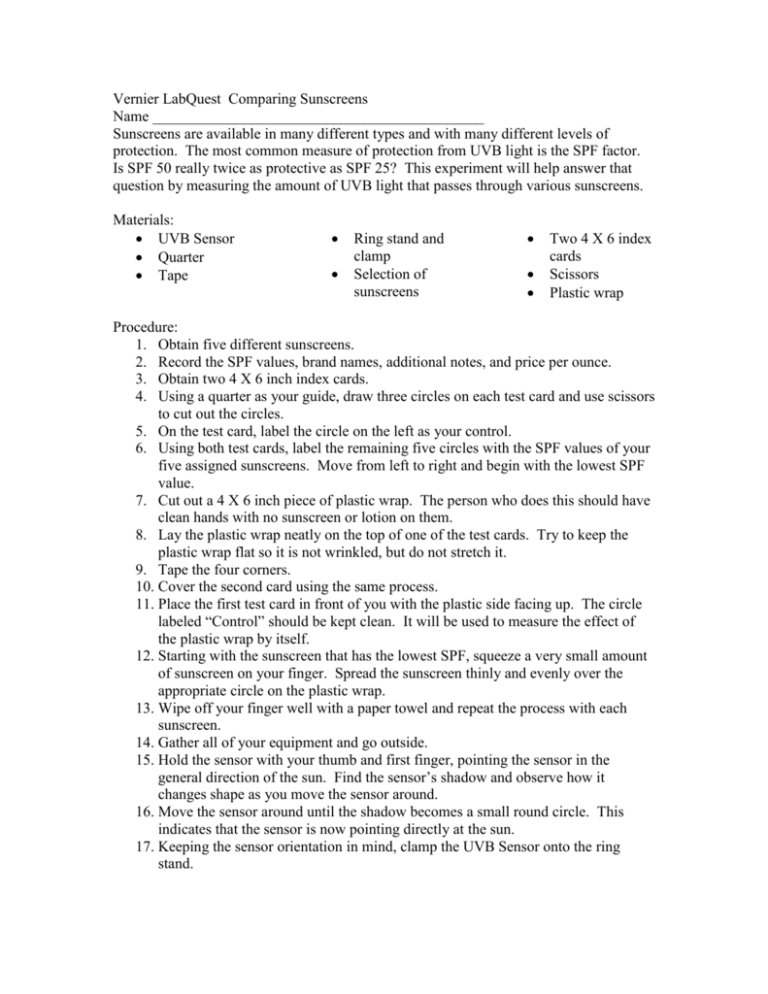
Vernier LabQuest Comparing Sunscreens Name ____________________________________________ Sunscreens are available in many different types and with many different levels of protection. The most common measure of protection from UVB light is the SPF factor. Is SPF 50 really twice as protective as SPF 25? This experiment will help answer that question by measuring the amount of UVB light that passes through various sunscreens. Materials: UVB Sensor Quarter Tape Ring stand and clamp Selection of sunscreens Two 4 X 6 index cards Scissors Plastic wrap Procedure: 1. Obtain five different sunscreens. 2. Record the SPF values, brand names, additional notes, and price per ounce. 3. Obtain two 4 X 6 inch index cards. 4. Using a quarter as your guide, draw three circles on each test card and use scissors to cut out the circles. 5. On the test card, label the circle on the left as your control. 6. Using both test cards, label the remaining five circles with the SPF values of your five assigned sunscreens. Move from left to right and begin with the lowest SPF value. 7. Cut out a 4 X 6 inch piece of plastic wrap. The person who does this should have clean hands with no sunscreen or lotion on them. 8. Lay the plastic wrap neatly on the top of one of the test cards. Try to keep the plastic wrap flat so it is not wrinkled, but do not stretch it. 9. Tape the four corners. 10. Cover the second card using the same process. 11. Place the first test card in front of you with the plastic side facing up. The circle labeled “Control” should be kept clean. It will be used to measure the effect of the plastic wrap by itself. 12. Starting with the sunscreen that has the lowest SPF, squeeze a very small amount of sunscreen on your finger. Spread the sunscreen thinly and evenly over the appropriate circle on the plastic wrap. 13. Wipe off your finger well with a paper towel and repeat the process with each sunscreen. 14. Gather all of your equipment and go outside. 15. Hold the sensor with your thumb and first finger, pointing the sensor in the general direction of the sun. Find the sensor’s shadow and observe how it changes shape as you move the sensor around. 16. Move the sensor around until the shadow becomes a small round circle. This indicates that the sensor is now pointing directly at the sun. 17. Keeping the sensor orientation in mind, clamp the UVB Sensor onto the ring stand. 18. Once the sensor is securely on the ring stand, use the shadow again to make final adjustments to assure that the sensor is pointing directly at the sun. 19. Connect the UVB Sensor to Lab Quest. Choose New from the File menu. 20. One the Meter screen, tap Mode, then change the data-collection mode to Events with Entry. 21. Enter the Event Name (SPF) and leave Units blank. Select OK. 22. Start data collection. 23. Hold the test card with the Control over the tip of the UVB Sensor. IMPORTANT: The side with the sunscreen should be facing out, away from the sensor. Sunscreen should never come in contact with the UVB Sensor. It is okay if the plastic lightly touches the tip of the sensor. 24. Tap Keep and enter 0 for SPF. Select OK to store the data pair. 25. Repeat this process to collect data for each sunscreen, entering the SPF value of the sunscreen. 26. Stop data collection. 27. To examine the graph of UVB light intensity vs SPF, tap any data point. The UVB light intensity and SPF values for that data pair will be displayed to the right of your graph. DATA SPF value on label SPF 0 (control) UVB intensity (mW/m2) Brand name N/A Additional notes on label (e.g. waterproof) N/A Price per ounce N/A DATA ANALYSIS: 1. Study your graph. Describe its shape in relation to how the UVB light intensity changed with different SPF values. 2. According to your data, would a sunscreen labeled SPF 50 block twice as much UVB light as SPF 25? Explain why or why not. 3. According to your data, did the price per ounce of any other factors such as being “waterproof” have any effect on the UVB measurements? Explain. TEACHER’S NOTES I did this lab with a couple of modifications. I had students do the same sunscreen films with both UV sensors. Students were able to hold the sensors (instead of the ring stand) and we were able to get results. The lab took about 45 minutes to complete. I had students complete this data table instead: UV A intensity (mw/m2) Sunscreen UV B intensity We compared generic to brand name and the scale of SPFs. We found that old sunscreen has a tendency to not be as effective. Students even tried out sunglasses and even regular glasses while we were outside. We discussed the difference between UVA and UVB and compared results to see if more absorbance occurred with the UVB rays. The ultraviolet portion of the electromagnetic spectrum ranges in wavelength from 400100 nm. The region from 400-315 nm is called UVA, and the region from 315-290 nm is called UVB. The UVA rays are responsible for the tan you get in the sun while the UVB rays cause you to burn. 700 nm Infrared ---------Visible 400 nm ------ 320 nm -----UVA UVB INCREASING ENERGY 290 nm ---- 100 nm x-rays
